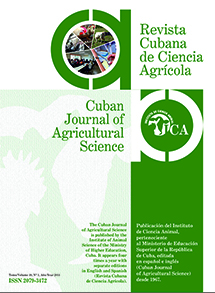Evaluation of the zootechnical additive SUBTILPROBIO® C-31 on feeding of laying hens in a commercial production unit
Contenido principal del artículo
Resumen
This study was conducted in a farm belonging to the Combinado Avícola de Matanzas, Cuba, using Leghorn L33 line laying hens, and lasted three months. The objetive of this study was to evaluate the zootechnical additive SUBTILPROBIO® for feeding laying hens. This additive was produced with strains of Bacillus subtilis, subtilis C-31 subspecies, in a concentration of 109 endospores/g. The experiment was conducted according to a completely randomized design, with two treatments: group I, base diet (maize-soybean) and group II: base diet + SUBTILPROBIO® C-31. An amount of 600 hens, with a mean weight of 1,192 grams and 113 days old was used, divided into 300 hens/treatment. Hens were located in cages under similar conditions of management and feeding.
In order to determine the probiotic effect of this zootechnical additive, liveweight, intake, conversion, total production of eggs and cracked eggs, and total disqualified eggs, as well as mortality, death by pecking, cannibalism and viability were evaluated. Results showed that hens consumed the zootechnical additive had a higher increase of productive indicators like liveweight (1640.0g/1585.0g), intake (10780 kg-1 DM), conversion (1.92/2.10), egg production (15,540/15,397), cracked eggs (1,092/1,114) and disqualified eggs (69/76) for P<0.01 regarding control group. In other indicators like mortality (1/4), viability (99.6/98.6 %) and death by pecking/cannibalism (1/2), there are no differences among
treatments. Results of this research demonstrate feasibility of the use of this zootechnical additive as improver of productive and health indicators for this category.
Key words: zootechnical additives, endospores of Bacillus subtilis, laying hens, eggs
In order to determine the probiotic effect of this zootechnical additive, liveweight, intake, conversion, total production of eggs and cracked eggs, and total disqualified eggs, as well as mortality, death by pecking, cannibalism and viability were evaluated. Results showed that hens consumed the zootechnical additive had a higher increase of productive indicators like liveweight (1640.0g/1585.0g), intake (10780 kg-1 DM), conversion (1.92/2.10), egg production (15,540/15,397), cracked eggs (1,092/1,114) and disqualified eggs (69/76) for P<0.01 regarding control group. In other indicators like mortality (1/4), viability (99.6/98.6 %) and death by pecking/cannibalism (1/2), there are no differences among
treatments. Results of this research demonstrate feasibility of the use of this zootechnical additive as improver of productive and health indicators for this category.
Key words: zootechnical additives, endospores of Bacillus subtilis, laying hens, eggs
Detalles del artículo
Cómo citar
Milián, G., Rodríguez, M., Dias, D., Rondón, A. I., Pérez, M. L., Bocourt, R., Portilla, Y., & Beruvides, A. (2019). Evaluation of the zootechnical additive SUBTILPROBIO® C-31 on feeding of laying hens in a commercial production unit. Cuban Journal of Agricultural Science, 53(2). Recuperado a partir de https://mail.cjascience.com/index.php/CJAS/article/view/885
Sección
Ciencia Animal
Aquellos autores/as que tengan publicaciones con esta revista, aceptan los términos siguientes:
- Los autores/as conservarán sus derechos de autor y garantizarán a la revista el derecho de primera publicación de su obra, el cuál estará simultáneamente sujeto a la Licencia Creative Commons Attribution-NonCommercial 4.0 International (CC BY-NC 4.0) que permite a terceros compartir la obra siempre que se indique su autor y su primera publicación esta revista. Bajo esta licencia el autor será libre de:
- Compartir — copiar y redistribuir el material en cualquier medio o formato
- Adaptar — remezclar, transformar y crear a partir del material
- El licenciador no puede revocar estas libertades mientras cumpla con los términos de la licencia
Bajo las siguientes condiciones:
- Reconocimiento — Debe reconocer adecuadamente la autoría, proporcionar un enlace a la licencia e indicar si se han realizado cambios. Puede hacerlo de cualquier manera razonable, pero no de una manera que sugiera que tiene el apoyo del licenciador o lo recibe por el uso que hace.
- NoComercial — No puede utilizar el material para una finalidad comercial.
- No hay restricciones adicionales — No puede aplicar términos legales o medidas tecnológicas que legalmente restrinjan realizar aquello que la licencia permite.
- Los autores/as podrán adoptar otros acuerdos de licencia no exclusiva de distribución de la versión de la obra publicada (p. ej.: depositarla en un archivo telemático institucional o publicarla en un volumen monográfico) siempre que se indique la publicación inicial en esta revista.
- Se permite y recomienda a los autores/as difundir su obra a través de Internet (p. ej.: en archivos telemáticos institucionales o en su página web) antes y durante el proceso de envío, lo cual puede producir intercambios interesantes y aumentar las citas de la obra publicada. (Véase El efecto del acceso abierto).
